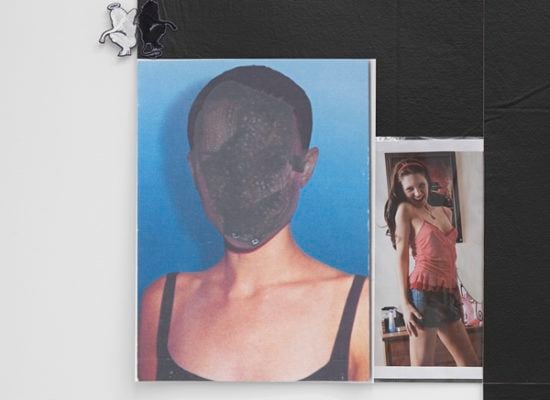Hot on the heels of her graduation from Yale’s painting MFA program, her first solo show on the Lower East Side at ROOM EAST, an upcoming group show at the Museum of Modern Art in Warsaw, and a rave review from New York magazine’s Jerry Saltz, Darja Bajagić is without question an emerging artist to watch out for. Just 24 years old, the Montenegro-born, New York-based artist has been a nomad since childhood, living in cities including Cairo and Chicago. Her work, which incorporates pornographic imagery and serial killer “murderabilia,” seems to be the beginning of a career that will surely garner a lot of the attention from the art world and the Internet.
Even before graduating, Bajagić was already whipping up controversy within the Yale MFA department, albeit unintentionally. The head of the department, art historian Robert Storr, had such a problem with her use of pornography that he called her crazy and suggested she go to therapy on Yale’s budget. Her interest in pornography, Bajagić says, is primarily cultural. She recalls her earlier works as being stylistically minimal, but she eventually sought to merge the conventions of painting and porn. By employing certain compositional strategies she wants to prod viewers into deconstructing her images, rather than simply seeing pornographic photos laden with gendered meaning, or focusing on why a female artist would be interested in pornography in the first place.
Her artwork opens up conversations on complex issues such as power struggles between the sexes, censorship, authorship, and the digital landscape. Her work elicits a broad spectrum of reactions and reviews that range from cautiously positive to harshly negative. But to say of her work’s success that “sex sells” or “it’s for shock value” would be reductive.
Growing up antisocial and with access to Web TV (an almost ancient way of accessing the Internet), there were only a few things to do: watch game shows and sports, or go on chat rooms. As a girl in her early teens, living in a very protective household, the artist made up several profiles of characters she would play online. Thus began her interest in collecting sexy or raunchy images of women. Her fascination with concealment and misdirection, something that is easily achieved through the Internet, is a common theme permeating her work. Bajagić’s more recent, multi-layered flap paintings flanked with laser cut-outs and patches purchased on eBay, as well as her serial killer art pieces (some of which contain information no one can see without altering the piece’s composition), speak to this idea.
Darja Bajagic, Dacha: Robert Bardo 8×11 ink drawing of porn star ‘Gauge’ (detail) (2014).
Photo: Courtesy of artist.
But again, why does she want to incorporate serial killer art? The artist says that after the adversity she encountered at Yale, she felt it wasn’t anyone’s place to say what kind of art a person should make. In fact, the department’s consistent negative critique of her practice helped fuel her appetite for making this type of work. One of her series juxtaposes the memorabilia she buys online at sites like Serialkillersink.net (a very controversial website) with images of a former Soviet surveillance agency director’s country home—where he kept his stash of illegal pornography. Such pieces question whether authority figures (let alone laypeople) should be given the power to pass judgement on who can and cannot make art.
Bajagić follows the generation of contemporary artists who first appropriated others’ imagery to make it their own—Richard Prince immediately comes to mind—but her work most certainly isn’t something you’ve seen before. It isn’t safe or pretty, and it forces viewers to face the most taboo, perverse, trashy, and fetishistic parts of our culture, an alternate world seemingly so distant, but lurking just a click away. While not many people want to aesthetically and conceptually engage with her work—perhaps because they can’t relate to porn stars and inmates, or simply from fear of things outside their comfort zone—the dialogue it creates will endure when most art simply aims to please.
What’s next for the rising artist? Besides working on her art, she will be collaborating with Oliver Vereker on the artwork for the second release from his experimental, noise-techno label, Endangered Species, slated for November. The music is his own, while the image set to accompany Vereker’s music is of Natalie Portman’s scratched out face, taken from Bajagić’s piece I’m Invisible Just Assholes Can See Me. Between his sonic tendencies and her artwork’s satanic references, the pairing evokes a scene like the opening club sequence in Stephen Norrington’s vampiric cult classic, Blade (1998)—minus the blood shower.
Bajagić will be featured in a group show, “New Systems, New Structures 001,” opening today at upstart Brooklyn gallery William Arnold. The gallery will be open on Sundays from 1–6 p.m., or by appointment only.
Endangered Species’ Restraint, front cover.
Photo: Courtesy the artist.
